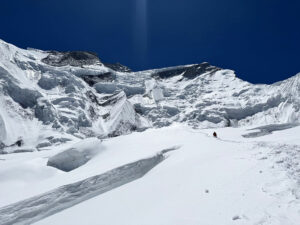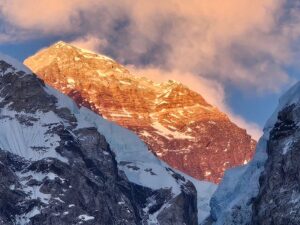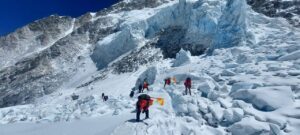Nepal’s Home Ministry has called for expedition agencies and tourism officials to make climbers return immediately from the mountains. For those high on Everest and Baruntse, returning is easier said than done.
While climbing permits are valid until the end of the month, the impact of Cyclone Yaas has prompted authorities to summon climbers down, the Everest News blog told ExplorersWeb. In fact, there may be little need for the official press release. On Everest, most teams at higher camps have switched their focus to getting down safely, in very tough conditions.
We still await news from Baruntse, where Marek Holecek and Radoslav Groh have been trapped after completing a new route. The exhausted pair, possibly without food or even fuel for melting water, are into their eighth day on the wall. Yesterday, they only managed to descend 100m. In Holecek’s latest message, he said that they would attempt to descend during the night.
In the storm
Heavy snowfall will continue until Saturday. This is bad news for Holecek and Groh, as well as for those on Everest. Many climbers are weathering the storm in Camp 2 or trying to get down the mountain.

Everest, Lhotse and Nuptse are somewhere behind these thick clouds today, May 27. Photo: Everest Weather Station
Nirmal Purja had planned to get to Camp 3 today. Instead, because of bad weather, he halted his team in Camp 2. “Our summit plan is May 30 for Everest and May 31 for Lhotse,” he wrote.
It is unclear what the weather will be like by then, and whether his team will manage to convince the Icefall Doctors to keep the route open, despite the government orders calling everyone back. Purja added that the wind has dropped but that there are some “snow showers.”

Nirmal Purja keeps morale high in Camp 2. Photo: Nirmal Purja/Elite Exped
Everyone on the mountain depends heavily on O2. Teams in Camp 2 suspect that other teams have used up their oxygen supplies in Camp 4. “We need the weather to be good enough tomorrow for the Sherpas to check on it,” explained Jenn Drummond, a member of Purja’s team. “Teams that summited on May 23 were stuck on the mountain for four extra days at high camps, so oxygen not belonging to those teams was potentially needed, and used.”
Dan Mazur’s Summit Climb team, which had a tough descent from the summit, mentioned that the team had used oxygen nonstop during their descent, including during an unplanned night in Camp 3.
Weather permitting, the teams pushing for the summit might try to get more oxygen brought up and wait one extra day in Camp 4. But inclement weather and the government announcement make this increasingly unlikely.
However, there might be some spare O2 bottles left by expeditions that recently aborted their climbs, such as Climbing The Seven Summits (CTSS). CTSS members stated they had to leave because they lacked enough Sherpa support on the mountain. COVID has heavily hit the Sherpas in that company.
No helicopters
Now back in Base Camp, Dan Mazur points out a potentially critical issue: Helicopters cannot fly in this weather. His team are tired after a very tough descent and want to fly back to town, but that isn’t possible. He has told his Sherpas, who need to go up and retrieve gear, rubbish and tents from the higher camps, to stay put until the weather improves.
Conditions are especially bad above Base Camp. Mazur described the scene: “Today thick clouds choke our camp in the gauzy fog of big fat snowflakes. A new white carpet of sticky late May snow coats the ground and every surface. Above us, a low leaden grey overcast ceiling obscures the peaks. Weather must be ripping inside there.”
Needless to say, helicopters are not available, either to remove sick climbers or to perform rescues at altitude. For now, climbers will have to look after themselves. In the end, despite technology, O2 and fixed-ropes, this is still Everest.






